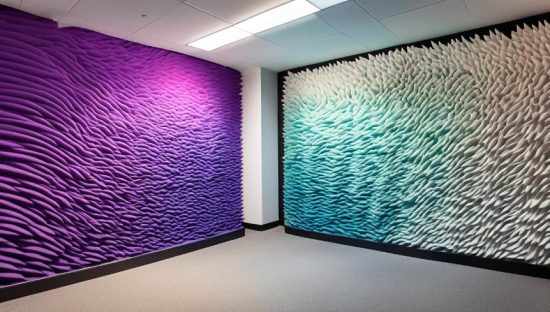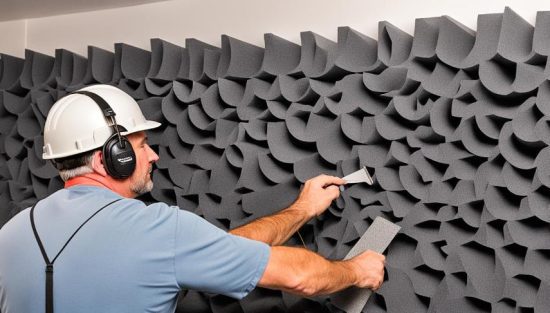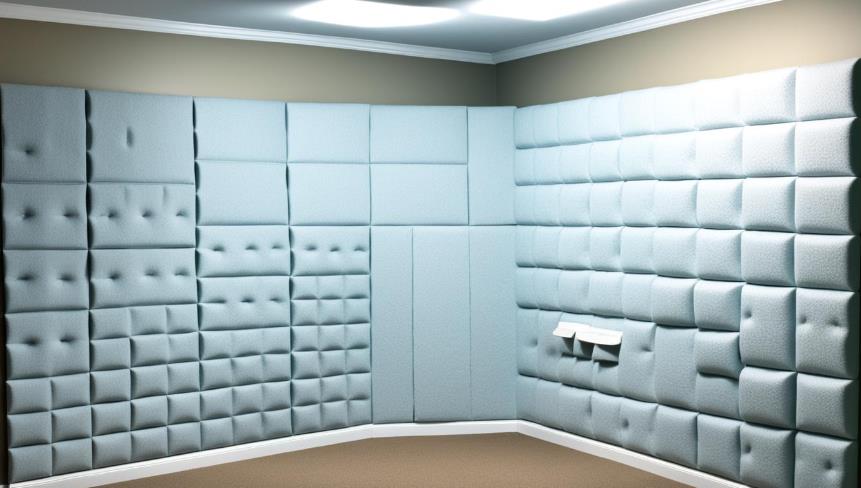Ever thought about the best way to block sound and make your space sound better? The best soundproofing needs the right foam. You have to think about the foam’s type, shape, thickness, and where to put it. Good soundproof foam is key to making any space sound great, whether it’s for work or fun.
It’s not just about covering everything in foam. We will look into how the right soundproof foam can make a big difference. You’ll see how to get the best sound without using foam everywhere.
What is a Acoustic Foam?
Acoustic foam is key for better sound in your room. Its structure is like a honeycomb. This design helps it soak up sound waves. So, it lowers the noise bouncing off walls and floors. But, how does this foam really make sound better?
Acoustic foam is unique for managing sound. It comes in open-cell and closed-cell types. Each type handles sound absorption differently. Open-cell types are good for mid to high sounds. Closed-cell ones work better for low sounds because they’re denser. This mix helps the foam improve your room’s sound without making it too quiet.
How Does Acoustic Foam Work?
Acoustic foam turns sound into heat to reduce noise. Sound goes into the foam’s holes. Then, it moves through the foam and loses energy as heat. This lowers the sound’s power and lessens echoes. It’s a smart way acoustic foam deals with sound. Does soundproofing foam work? Yes, it’s great at soaking up noise and making rooms sound better. But, remember, acoustic foam doesn’t block all sound. You choose the right type based on what sounds you need to deal with. This ensures your room has the best sound quality possible.
Places like Soundproof Cow sell many foam products. They have foam panels, bass traps, and more. By placing these in the right spots, your room’s sound can be just right. It’ll be clear and pleasant to hear.
Materials Used in Acoustic Foam
Many materials are used in acoustic foam. Each type has its own soundproofing features. This range means there’s a solution for all spaces, from studios to homes.
Following are some important materials:
Open-cell Polyurethane Foam
Open-cell polyurethane foam stands out in soundproofing. It’s often made from polyether or polyester. And, it’s great at stopping echoes in medium and high sounds. It’s common in places like restaurants, music halls, and studios. With many color, size, and thickness options, it matches both your sound and visual needs well.
Composite Materials
Composite soundproofing uses materials like glass wool. They lower noise well, especially when thicker. These materials are safe and last long thanks to treatments like dyes and fire retardants. The different density levels help block specific sound frequencies. This makes composite soundproofing good for adjusting the sound in a room to fit your needs.
Extruded Melamine
Extruded melamine is great at handling various sound types. Its foam is shaped into tiles that look like pyramids, cones, or wedges. This shaping improves its ability to absorb sound. With a high PPI rating and a hardwearing design, it lasts a long time. Using melamine foam boosts sound treatment and its life span.
Advantages of Using Soundproof Foam

Soundproof foam is great for many spaces, providing key acoustic benefits. It’s commonly used in home theaters, workshops, schools, churches, warehouses, offices, sports halls, and theaters. These places need soundproofing to lessen loud sounds from the environment.
Reduction in Echo and Reverberation
Soundproof foam cuts down on echo and dampens the sound bouncing off walls. It works by absorbing sound waves, thus decreasing noise pollution. This action helps spaces control noise better. It does this by focusing on certain sound frequencies, turning sound energy into heat, and keeping a gap between the foam and walls.
Improved Sound Quality
Soundproof foam greatly improves how we hear sound, especially where clarity matters. It decreases echo and reverb, enhancing sound quality. It’s very popular in music studios and professional working areas. There are many colors, textures, sizes, and thicknesses to match any room’s design.
Cost-effective Soundproofing Solution
Choosing soundproof foam over things like concrete or special panels is cost-effective. It still does a great job at reducing noise and enhancing sound quality, but without the high cost. However, how well soundproof foam works depends on how it’s installed. It’s best to have professionals set it up for you.
Different Shapes of Acoustic Foam
Acoustic foam is crucial for good sound spaces. Its shape greatly affects its use for soundproofing and cutting echoes. Let’s look at the most common shapes and how they work.
- Egg Crate; Egg crate foam is a top pick for those on a budget. It’s great at absorbing sound, especially from the mid-to-high range. This pattern helps cut down on sound bouncing around.
- Wedge; Wedge foam has a unique look and is good at guiding sound. It might not stop all sound reflections, though. It’s a top choice for places that need clear sound, like recording studios.
- Pyramid; Pyramid foam looks good and does a fine job at absorbing high-pitched sounds. It isn’t super at absorbing lower sounds. This foam is perfect for making sounds clear without too much echo.
- Grid; Grid foam not only looks nice but also works well in small spaces. It balances good looks with effective soundproofing. It’s ideal for places like homes where both sound quality and looks matter.
- Bass Traps; Bass traps are key for handling lower sounds when overall soundproofing. They’re put in corners to capture the deep, lingering sounds. Bass traps help keep the sound clear and balanced in any room.
How to Choose the Best Acoustic Foam for Your Needs

When picking soundproofing foam, think about what you need it for. Consider the environment’s sound and your budget. There are key points to think about when choosing the right foam.
Assessing Your Sound Environment
The first step is understanding your sound needs. Decide the room’s size and what it’s used for to pick the right foam. Use open-cell foam for low-frequency sounds. It’s good for cutting down on background noise and human voices. Closed-cell foam works better for high-frequency noises. Using both foam and panels can improve overall sound reduction.
Considering Material and Thickness
It’s important to match the foam’s material and thickness to your sound challenges. Choose open-cell polyurethane or other materials based on their absorption abilities. Thicker foams are better at soaking up low-frequency sounds. For example, businesses might use 1-inch foam, while home studios might prefer 2-inch foam. Larger rooms with more bass might need even thicker foams, up to 4 inches. Just be careful in small rooms, as very thick foam can make things too quiet.
Balancing Budget and Performance
Finding a balance between cost and performance is key. While top-quality materials are pricier, they offer better sound control. By mixing less expensive foam with some high-end panels, you can get great results without breaking the bank.
The Role of Thickness in Sound Absorption
It’s key to know how the thickness of acoustic foam panels impacts sound absorption. This knowledge is important for creating the best acoustic environment. Different foam thicknesses are more effective for certain sound frequencies.
1-inch Foam for Basic Sound Control
1-inch foam is great for controlling basic sound. It absorbs noise well, perfect for places like offices that need some quiet. They’re not the best for blocking low sounds but work well against high noises.
2-inch Foam for Mid-range Frequencies
For better control, try 2-inch foam. It’s good for places like vocal booths, theaters, and studios. With its extra thickness, it absorbs high and mid-range sounds, which makes sounds clearer. These options are great for serious sound control without making the room too dead-sounding.
3- and 4-inch Foam for Low Frequencies
If you have problems with low sounds, 3- and 4-inch foam is your best bet. They tackle a wider sound range, including those hard-to-deal-with bass sounds. But, too much of the 4-inch foam in a small space can make it too quiet.
| Foam Thickness | Ideal Application | Primary Frequencies Absorbed |
|---|---|---|
| 1-inch | Business Environments | High Frequencies |
| 2-inch | Home Theaters, Studios | High and Mid Frequencies |
| 3- and 4-inch | Low-Frequency Soundproofing | Full Frequency Range |
Understanding how foam thickness affects sound absorption is crucial. It’s all about finding the right balance. Choose the right foam for your space’s needs to get good results, especially for dealing with low sounds.
Installation Tips for Acoustic Foam

Installing acoustic foam right is key for great sound absorption. It ensures a room sounds its best. This involves putting foam on walls, ceilings, and floors correctly. You also need to use the right methods, such as adhesive sound dampening.
Placement on Walls
First, clean the wall with isopropyl alcohol for best adhesion. Always place foam opposite speakers to limit sound bouncing around. Use proper measurements to look good and sound great. Foam kits from Soundproof Cow are perfect for different room sizes.
Installing on Ceilings and Floors
Adding foam on ceilings and floors improves soundproofing. It’s great for places that need to be really quiet, like recording studios. Use strong adhesives to stick the foam securely. Pyramid Acoustic Foam panels are ideal for this job. They have more surfaces to absorb sound.
Using Adhesive Sound Dampening Clips
Adhesive sound dampening clips make installing foam easier without damaging walls. They allow for easy shifting of foam if you need to. For high sound absorption, use foam like Udderly Quiet™ Anechoic. Press the foam against the wall for 30 seconds firmly after applying.
Soundproof Foam vs Acoustic Panels
In comparing soundproof foam with panels, it’s key to know their differences in material and use. Each type serves a special purpose. They give various benefits based on where and how you need to control noise.
Material and Purpose
Acoustic panels are usually made from materials like fiberglass or mineral wool. They come in sizes up to 4’ x 10’. These panels are great for absorbing sound from all frequencies. They are perfect for places where you need to hear clearly and the sound is balanced. On the other hand, soundproof foam comes in segments from 1’ x 1’ to 4’ x 8’. It’s best at absorbing high-frequency sounds above 2 or 3 kHz. This makes it perfect for places like home recording studios or music rooms.
Best Use Cases for Each
Acoustic panels work well in big places that get a lot of people, like theaters and conference rooms. They’re also good for home theaters or schools where the sound needs to be just right. You can pick them in many colors and patterns, making them look good too. But, for smaller, more private areas like home studios, soundproof foam is your best bet. It might not be as good with all sounds as panels, but it’s top-notch with high-pitched noises and cuts down on the echo.
Cost and Installation Differences
Soundproof foam is usually more affordable because it’s simple. It is a perfect choice for those who like to do things themselves. Acoustic panels, however, can be more expensive. This is because they are made of more parts and are bigger. Yet, they can absorb more sounds across a larger range of frequencies. This often makes the cost worth it, especially in places that need special sound treatment.
Popular Brands and Budget-Friendly Options
Finding good soundproofing can be tough but knowing the best brands is key. There are many options out there that suit different needs. This is especially important for home studios that don’t want to spend too much.
Top Recommended Brands
Experts often recommend brands like Auralex, SilentSpace, and Foam Factory for their quality. Auralex has unique shapes for better sound absorption. SilentSpace is great for sound absorption and long-lasting use. Foam Factory offers various thicknesses, ensuring you find what you need.
Affordable Picks for Home Studios

If you’re on a budget, Noico and Focal BAM are great choices. Noico has sheets for wall soundproofing that don’t cost much. Focal BAM makes budget-friendly foam panels for reducing noise. These options are thicker for better sound control.
| Brand | Product | Key Features | Price Range |
|---|---|---|---|
| Auralex | Studiofoam Wedges | High-Density, Excellent Sound Absorption | $50 – $150 |
| SilentSpace | Acoustic Panels | Durable, Superior Sound Absorption | $75 – $200 |
| Foam Factory | Convoluted Acoustic Foam | Diverse Thicknesses, Open-Cell Structure | $30 – $100 |
| Noico | Neoprene Sound Barrier Sheets | Cost-Effective, Easy to Install | $20 – $70 |
| Focal BAM | Soundproof Foam Panels | Thicker Foam, Budget-Friendly | $25 – $75 |
Common Mistakes to Avoid in Acoustic Treatment
For good acoustic treatment, it’s vital to know the top mistakes. These mistakes stop you from soundproofing correctly and dealing with unique room needs. Many people forget to check the room’s acoustics before starting to soundproof. This mistake can lead to treatments that don’t work well.
Over-treating the Room
Over-treating a room can make it too quiet, like a dead zone. This happens when you use too many sound-absorbent materials. Balancing these materials with reflective ones keeps the sound natural. Tools like the SPL meter and RT60 meter are great for checking the room. They give you data to help make the right choices.
Neglecting Important Areas
Ignoring areas with a lot of sound leak or echo is a big mistake. Don’t forget doors, windows, and side paths. Use materials like resilient channels and acoustic caulk on these spots. Equipment like frequency response and impulse response tools can find these weak points for you.
Ignoring Room Specifics
Not considering the unique parts of your room can ruin your soundproofing. Using the wrong materials, like low-density foam, can make soundproofing bad. Know the difference between soundproofing and sound absorption. Use measurements like STC, IIC, NRC, and dB to classify materials and spaces well.
To avoid these common acoustic treatment mistakes, be aware and plan carefully. Consider the right soundproofing methods and the specific needs of your room. This ensures you have great sound quality and control in your space.
- Look at your room’s acoustics before you start soundproofing.
- Measure noise in your space with the right tools.
- Avoid bad materials like mattresses, cardboard, and low-density foam.
- Deal with noise paths to stop problems.
- Use special materials like resilient channels and acoustic caulk the right way.
- Know the difference noise control and soundproofing.
- Get advice from pros for your soundproofing work.
- Use a mix of soundproofing products for the best outcomes.
- Don’t fall for common myths about soundproofing.
Combining Acoustic Foam with Other Treatments
To upgrade sound quality, think about using acoustic foam alongside other soundproofing tech. The right mix of treatments absorbs and spreads sound better. This mix boosts sound quality, making it more even and enjoyable.
Using Rugs and Carpets
Rugs and carpets boost the benefits of acoustic foam. They absorb sound that hits the floor, cutting down on echoes. For rooms of various sizes, the right amount of floor covering can enhance your space’s sound quality.
Adding Curtains or Blinds
Thick curtains or blinds at windows can improve sound absorption too. They keep noise out and noises inside from bouncing around. This helps balance sounds throughout your space.
Incorporating Diffuser Panels
Diffuser panels help spread sound evenly around the space. Using them with acoustic foam makes for a complete sound setup. This is key for a top-notch sound experience.
Using these strategies with acoustic foam is a smart way to tackle soundproofing. It ensures sound quality is top-notch everywhere in the room. From deep bass to high treble, you’ll get crystal-clear sound.
Where to Buy the Best Soundproof Foam

Looking to buy top-quality soundproof foam? There are key things to think about. Many online stores and local shops have acoustic foam for sale. By checking their products, prices, and how they help customers, you can find the best foam for you.
Consider discounts when shopping. An example is getting 17% off on certain foam panels. These panels are about 19.7×19.7 inches and are good for places like studios or theaters. They vary in thickness, useful for different soundproofing needs.
Think about shipping too. Some foam products can save you 75% on shipping because they are compressed. They’re lightweight yet durable, which means they work well and last. This is great for anyone looking to soundproof on a budget.
Checking reviews can guide your purchase. For instance, the “2 Inch Sound Foam 12″ x 12″ x 2″ Absorbing Sound in Home & Offices” has 364 reviews. It is well-liked. There are also affordable yet rated foam options like “Noise Isolation Foam 12″ x 12″ x 2″ Soundproof Wedges 5 Block Tiles”. Whether you shop in-store or online, follow these tips for a good buy.
FAQs on Soundproofing Foam
What Kind of Foam is Best for Soundproofing?
The best foam for soundproofing is acoustic foam, specifically designed to absorb sound waves and reduce noise. It is typically made from open-cell polyurethane foam, which is effective in dampening sound and improving acoustics in a room
What is the Best Material to Block Sound?
Mass-loaded vinyl (MLV) is often considered one of the best materials to block sound. It is dense, flexible, and effective at blocking airborne noise, making it ideal for soundproofing walls, floors, and ceilings.
What Are the Disadvantages of Soundproof Foam?
The disadvantages of soundproof foam include its limited effectiveness at blocking low-frequency noises, such as those from traffic or heavy machinery. Additionally, some types of foam may deteriorate over time and release particles into the air, which can be a concern for indoor air quality.

